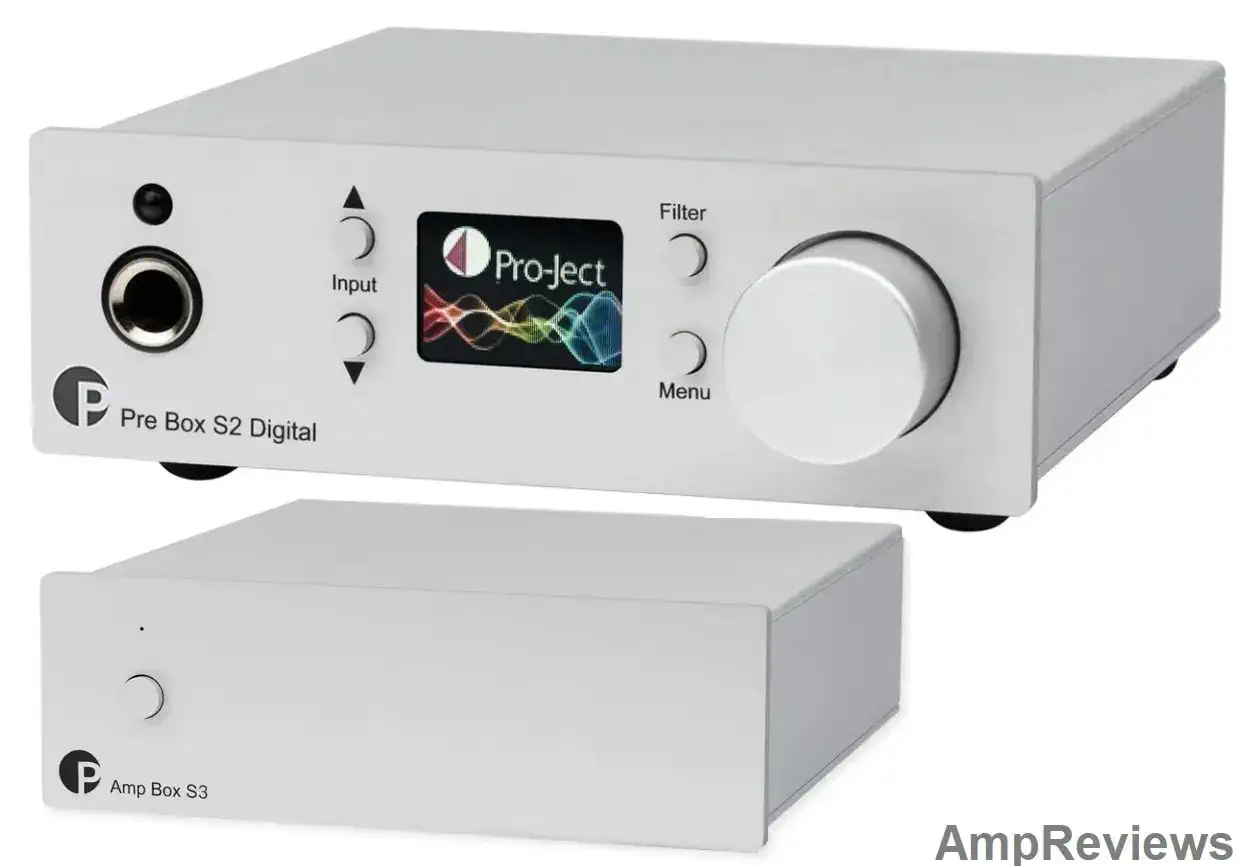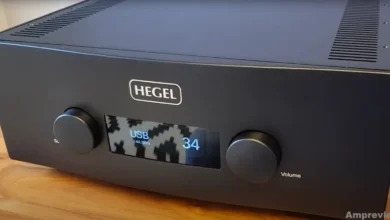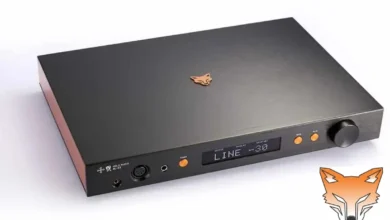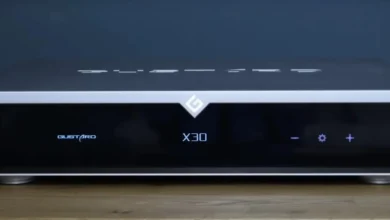

Compact, space-saving hi-fi is popular. There are midi-size components, mini and micro. The cute preamp/DAC Pro-Ject Pre Box S2 Digital and the brand new power amp Amp Box S3 could even be called nano-hi-fi. Nevertheless, these are full-fledged audio components with a considerable range of functions, good sound, and respectable output power – as the detailed LowBeats test has shown.
All-in-one active loudspeakers are undoubtedly the most space-saving way of providing music. The full integration of digital, streaming, and amplifier electronics, plus any additional sources such as radio or CD playback in housing with integrated speakers, also has an often underestimated disadvantage: Putting all your eggs in one basket is dangerous. If just one module fails due to a defect, the entire loudspeaker system must be sent for repair.
The fact that the user has no influence on the individual components of all-in-one systems and cannot exchange them individually is probably even more relevant in practice. If at some point the desire for a sound improvement or an increase in performance arises, a complete replacement becomes necessary with an all-in-one system. If, on the other hand, you opt for passive loudspeakers and individual electronic components, the chain can be easily retrofitted and upgraded.
The route via individual components is associated with greater cabling effort and space requirements. After all, additional devices have to be housed somewhere. Thanks to state-of-the-art circuit technology, hi-fi components can now be made very small. The electronics series S2/S3 from Pro-Ject is a wonderful example of the successful downsizing of hi-fi components.
From what is now quite an extensive range of Pro-Ject components in this series, we have decided to test a particularly versatile dual solution. The Pre Box S2 Digital and the stereo power amplifier Amp Box S3 can do almost everything except network streaming. With the Streaming Box S2 and S2 Ultra, there are two other components in the Pro-Ject portfolio.
In general, the S2/S3 series, with currently 18 components, offers numerous options for putting together a chain specifically for your own needs or adding special components. In addition to the test candidates and the streaming components, this also includes DACs, phono amps, headphone amplifiers, FM tuners, and other special solutions. However, our two test candidates already cover a very large spectrum in terms of functionality.


As the name suggests, the Pre Box S2 Digital specializes in digital music sources and serves as a high-quality D/A converter (DAC) as well as a preamp and headphone amplifier – with remote control. Supplemented with the new Amp Box S3, this results in a wonderful amplifier team for passive loudspeakers that not only fits on every desktop but also comfortably on a bookshelf. The dimensions are around 103 x 37 x 120 mm per device. In combination, this is much smaller than my desktop reference in midi format, consisting of the Questyle CMA fifteen (DAC, pre/headphone amplifier) and the stereo power amplifier T+AA 200. – With a very similar range of functions. And with a total of around 700 euros, it is also considerably cheaper.
Although the small Pro-Jects can’t hold a candle to the references technically, their data still makes you sit up and take notice. Here are just the most important:
Pro-Ject Pre Box S2 Digital & Amp Box S3 Features
Three digital inputs: 1 x coaxial, 1 x optical, 1 x USB
Double mono construction
Integrated headphone amplifier with 6.3mm jack socket
Preamp output with mute for headphone use, separate LS control (see note below)
Four-color OLED display
Can be powered by an AC adapter (included) or USB bus power
D/A converter: ESS Saber ESS9038
DSD512, PCM 32Bit/768kHz; eight filter variants
proprietary clock design for low-jitter
MQA support
Roon Tested (via USB on the computer)
Four-layer gold plated circuit board, high-quality components/connectors
Remote controllable (simple remote included, high-quality IR transmitter optional)
Note: If the LS controller is set to maximum in the PreDAC operating mode, the device basically acts as a DAC. After the Pre Box S2 Digital remembers the set volume in both operating modes, it remains so after switching back from headphone mode to the DAC function (DAC function because volume is set to max. and remembered).
Amp Box S3:
Efficient switching amplifier with 2 x 23 watts at 8 ohms / 40 watts at 4 ohms
Loop-through output for bi/tri-amping operation
external power supply (included)
Trigger in/out
compact but very solid speaker terminals (cable lugs/bananas)
new PCB concept, less distortion/noise compared to Amp Box S2
The whole structure, including the very solid aluminum housing, makes it clear that this is not a toy solution, but full-fledged hi-fi components with high sound standards.
Sure, with an output of 2 x 23 W at 8 ohms, the power amp can’t uproot any trees and is unsuitable for every speaker. However, the range of suitable speakers is still large for suitable compact or floor-standing loudspeakers with medium to high efficiency (and not too critical impedance). At least on paper. How the Amp Box S3 behaves in practice is explained below.
Setup and connections
For the test, the German Pro-Ject distributor Audio Trade gave us a very nicely made Connect-It cinch cable with a length of 41 cm (59 euros). Funnily enough, that’s almost too long for the small station wagon, whether stacked or standing side by side. The cable is also available in a length of 20.5 cm. Complete with cables and power supplies, the team looks like this:
External power supplies are not very popular and they also put the compactness of the system into perspective. But they are an effective measure to keep interference away from the device electronics and small enough to disappear behind the cupboard or shelf, never to be seen again. Out of sight, out of mind.
If you connect a Mac, PC, or even a Roon Core to the preamplifier via USB, you can also omit the supplied plug-in power supply. The Pre Box S2 can also be operated via USB bus voltage. From a sound point of view, however, we recommend using the supplied power supply unit – or a higher-quality additional power supply unit. Pro-Ject has the Accu Box S2 (259 euros) in its range for this purpose. Experience shows again and again how positively a stable and pure mains supply affects the sound.
When connecting the components, there is a small flaw in the otherwise very well-thought-out device concept. Although the power amp offers trigger connections for remote activation, the Pre Box S2 Digital does not. Its analog brother Pre Box S2 Analogue, on the other hand, has a matching trigger output. Whoever wants to understand that. In practice, this means that the power amplifier in this combination has to be switched on and off manually using the button on the front panel, while the preamplifier can also be conveniently ordered to work from the armchair using the remote control.
The wired digital inputs of the preamp, consisting of USB-B (audio) as well as S/PDIF electrical and optical, have to match the user’s requirements very precisely, otherwise, you will quickly have a connection problem. USB is ideal for connecting to computers, but a Roon Core, such as the Silent Angel Rhein Z1 ( test report ), can also be connected via it.
The electrical S/PDIF input (the single RCA jack) is a rare sight these days. It is most suitable for connecting a CD drive (without its converter) or CD player with a digital output.
An optical TosLink output can be found on almost every TV and this is a very reliable and good-quality connection to play back sound from the TV via the system. But more and more modern TV and hi-fi components rely on HDMI ARC with CEC control. It’s not just the sound that’s transmitted digitally. The volume control and on/off can also be done using the TV remote control. Unfortunately, such an HDMI socket is missing here. In contrast, Toslink still has the advantage of galvanic isolation, which prevents any ground loops.
You May Like Headphone Amplifiers: Types,
There is no analog input on the Pre Box S2 Digital. On the output side, a stereo power amplifier can be connected via the controlled stereo cinch output. In short: You should think very carefully before you buy whether the offered connections are sufficient. Unfortunately, the high degree of specialization of the entire Pro-Ject S2/S3 series also makes the choice somewhat difficult. Because it is important to put together exactly the right combination of devices for your own needs without missing an important function or connection type afterward. On the plus side of the Pro-Ject concept is that due to the precise selection, not so many connections are paid for and later remain unused, as is often the case with many conventional amplifiers.
With the Amp Box S3 power amp, things are simpler: one analog input, two pairs of speaker outputs. More is usually not required. The fact that the trigger connections have to remain unused in combination with the Pre Box S3 Digital is a shortcoming of the preamp.
Briefly to the integrated headphone amplifier of the Pre Box S2 Digital. With 2 x 68mW at 32 ohms, its output is sufficient for most headphones, but cannot be compared with real bolides such as the Questyle CMA Fifteen (2,000 mW at 32Ω). As with amplifier/loudspeaker combinations, such performance specifications are always very relative and not fully meaningful on their own, but even an iFi Audio ZEN DAC ( test report ), which can also be fed via USB bus power, clearly offers 230 mW at 32 ohms more reserves for more demanding headphones. You can read about whether and how this works in practice in the following listening test section.
Sound Test Pre Box S2 Digital Preamp w/ DAC & Headphone Amp
Of course, the dimensions and range of functions of the two Pro-Ject minis lend themselves to a test on the desktop, connected to the Mac via USB and fed via Roon. The Wilson Audio TuneTot served as a monitoring monitor and incorruptible reference ( test report ). Although they are not a suitable combination in terms of price, they relentlessly reveal the potential of the upstream electronics. In addition, they are good playing partners for the Amp Box S3 with their efficiency of 86 dB – which is quite good for compact two-way loudspeakers – and an uncritical impedance curve.
The components from Questyle and T+A mentioned above served as the upper benchmark for the electronics. As a preamp and headphone amplifier, the Pre Box S2 Digital also had to hold its own against the iFi Audio ZEN DAC (1st generation), which costs only half as much at around 200 euros, but can also do less: no display, no remote control, simpler DAC chip, fewer inputs. The iFi is a real challenge, especially with the headphone output.
To cut a long story short: The tiny pre/power amp combination, which looks tiny next to an not huge MacStudio and compared to the Questyle T+A combo, offers grown-up hi-fi qualities. It is worthy of all credit how naturally and precisely the Amp Box S3 drives the small Wilson speakers. A liveliness and control that only gets a little out of step at very high levels. Of course, die-hards could add a second Amp Box S3: for bi-amping. Then of course you have more reserves…
In a direct comparison to the Questyle T+A combo, however, the limits also become clear at low to medium levels. The basses don’t seem as massive, deep, or hard, the mids don’t achieve the same transparency and spatiality, and the highs can get a little pointed here and there. Not a fair comparison, but such comparisons with much more expensive references are helpful for adjustment and assessment.
A more suitable opponent in terms of price is the Nubert nuConnect ampX ( test report ). It also costs just under 700 euros, has more functions and connections (including HDMI and analog), but is significantly larger and the DAC is far from being as well equipped. The Pro-Jects are a bit more audiophile in their entire claim.
In the test, Nubert amps seemed very lively and lively at the time, but also a little too artificial, and emotionally not so appealing. This impression does not arise with the Pro-Ject combination. The music has a nice, natural flow and warm atmosphere with them, without omitting important details. Especially about the purely digital pre-stage, that’s a lot of praise.
A similar picture emerges when using headphones with the Pre Box S2 digital. Incidentally, I mainly listened here with the Fostex TH909 ( test report ), which should ideally match the Pro-Ject with its sensitivity and impedance and with its resolving power unmasks every weakness of the upstream amp.
Clear, sparkling, jumping, with a lot of lard and verve. This is how the sound of the headphone preamp can be summarized. But compared to the iFi Audio ZEN DAC, the Pro-Ject cannot quite hold its own, as the “Zen Master” offers noticeably more control in the bass and lets the high-frequency range of the very demanding Fostex sound a bit finer and more relaxed. Headphones with more treble restraint and not too high impedance are recommended for the Pro-Ject.
This impression was reinforced all the more in comparison to the quest style, which plays in a completely different league here. The bottom line is that I can’t help but give the headphone output of the Pre Box S2 Digital the status of a nice addition. It does its job well, but those who value headphone enjoyment should consider buying one of the DS2 B or RS head boxes in the Pro-Ject range.
Conclusion Pro-Ject Pre Box S2 Digital and Amp Box S3
It works! And much better than you would give these cute little devices credit for. The Pro-Ject Pre Box Digital is a serious DAC and preamp for the main digital sources, plus a headphone jack. The Amp Box S3 stereo power amplifier is an equally impressive “nano-sized” power amplifier with great sonic capabilities for connection to a huge selection of passive loudspeakers.
If you are looking for an affordable and space-saving audio component solution, you can hardly avoid the Pro-Ject S2/S3 series. There are many possible combinations, but you are also spoiled for choice. The two test candidates are an ideal team for desktop hi-fi, to upgrade the media center in the living room, or as a second system in other rooms.
Pro-Ject Pre Box S2 Digital
Concept: DAC and preamp, for digital sources only; headphone amplifier
Particularities: DAC up to 768kHz/32Bit PCM and DSD512
Inputs: USB, S/PDIF Coax and Toslink
Outputs: Pre-Out (regulated) via cinch
12V triggers: no
Dimensions (W x H x D): 103*37*122mm
Weight: 366g





GIPHY App Key not set. Please check settings